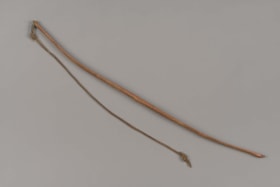Narrow Results By
B.C. Relief Camp #343 Spuzzum. Bunkhouse No. 6
https://search.heritageburnaby.ca/link/museumdescription3696
- Repository
- Burnaby Village Museum
- Date
- [193-]
- Collection/Fonds
- Harold Edward Winch collection
- Description Level
- Item
- Physical Description
- 1 photograph : sepia ; 8 x 12.4 cm
- Scope and Content
- Item is a photographic postcard of men in a cabin in a relief camp in Spuzzum, British Columbia during the Depression. Harold Winch acted as a liaison between workers and the government during the 1930s.
- Repository
- Burnaby Village Museum
- Collection/Fonds
- Harold Edward Winch collection
- Description Level
- Item
- Physical Description
- 1 photograph : sepia ; 8 x 12.4 cm
- Scope and Content
- Item is a photographic postcard of men in a cabin in a relief camp in Spuzzum, British Columbia during the Depression. Harold Winch acted as a liaison between workers and the government during the 1930s.
- Accession Code
- BV013.12.53
- Date
- [193-]
- Media Type
- Photograph
- Notes
- Title based on contents of photograph
- Photograph is a part of original scrapbook Item BV013.12.11
Images
hunting bow
https://search.heritageburnaby.ca/link/museumartifact16840
- Repository
- Burnaby Village Museum
- Accession Code
- HV980.2.132
- Description
- Small maple hunting bow. A leather thong is tied to one end of the bow. It is loose at the other end, although, there is a knot that could slip over the bow. There are traces of green paint on the wood. Interior Salish: Nlaka’pamux: Spuzzum First Nation
- Object History
- Homer Barnett writes about Coast Salish bows: “the main hunting bow did not differ from the one used in fighting. It was made of yellow cedar root when this wood could be obtained from the mountains. The trunk wood was also used. An alternative was yew. Inferior bows for ducks and other birds were made from hardhack. Bows were about three or four feet long/ The were rather flat and were about the breadth of three fingers at the widest parts on either side of the grip, which was constricted and slightly thicker. They tapered from the centre towards both ends. The ends were curved away from the holder for a better string purchase (1955:100)
- Plant fibres were seldom made into bow strings. More common were two-ply cords of sinew or gut. Atypically, a skin thong was used (1955:101).
- Marks/Labels
- There is writing inscribed on the inside of the bow, which reads: “1925" "Made for me by Spuzzum chief.”
- Country Made
- Canada
- Province Made
- British Columbia
- Site/City Made
- Spuzzum
- School/Style
- Coast Salish
- Culture
- Nlaka'pamux
![B.C. Relief Camp #343 Spuzzum. Bunkhouse No. 6, [193-] thumbnail](/media/hpo/_Data/_BVM_Images/2013/2013_0012_0053_001.jpg?width=280)
